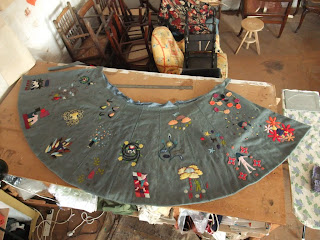Repairing Beaded Man
Starting slowly, so I don't make any irreversible decisions, I'm surveying, measuring and photographing Beaded Man.
My first idea was to make a 'skin' for the figure and then put stuffing inbetweeen the armature and the 'skin' layer, but the original clay surface was quite uneven so the shape of the figure isn't smooth like a stuffed doll.
If I build up layers of thicker material I can model the surface in a similar way to building with clay.
This way of building up the figure gives a surface topography much closer to the original. But doing this bit of pinning, I noticed that the heads of the pins weren't actually big enough to hold the beads on. Some of the beads lost the mirror layer inside the hole as I was cleaning them, and the pins are short sequin pins to allow for the shallower depth of material over the plaster armature on the head, so may have slightly smaller heads.
I'm supposing that the damp clay held onto the beads sufficiently so that this issue didn't arise originally.
The next set of trials will be with wax or at least wax based media which can impregnate the wool felt material and make an additional layer for the beads to sink into slightly. In combination with a 'varnish' layer, the beaded areas should be made stable again.
The only intervention I've made so far is to start cleaning up the beads and pins from the broken head.
 |
| pins and beads soak in water then have the clay and glue cleaned off by hand individually. a very slow process. |
Although I'm treating the project as a 're-make' rather than 'restore', I'm re-using as much of the original material as is practical. If I'm sensible this will be all the beading, most of the pins, the fabric patches and the plaster armature and wooden base.
The scary part is the fact that a lot of the modelling on the figure was done in unfired clay which is now disintegrating. My plan for replacing it is to start some trials in an alternative material, which will allow for the decorative layer to be put back and look the same as it did originally.
If I build up layers of thicker material I can model the surface in a similar way to building with clay.
This way of building up the figure gives a surface topography much closer to the original. But doing this bit of pinning, I noticed that the heads of the pins weren't actually big enough to hold the beads on. Some of the beads lost the mirror layer inside the hole as I was cleaning them, and the pins are short sequin pins to allow for the shallower depth of material over the plaster armature on the head, so may have slightly smaller heads.
I'm supposing that the damp clay held onto the beads sufficiently so that this issue didn't arise originally.
The next set of trials will be with wax or at least wax based media which can impregnate the wool felt material and make an additional layer for the beads to sink into slightly. In combination with a 'varnish' layer, the beaded areas should be made stable again.







Comments
Post a Comment